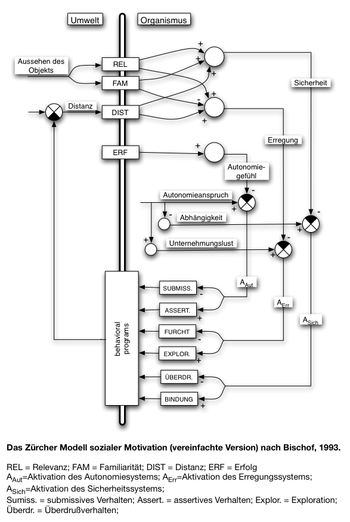Zurich model of social motivation
The Zurich model of social motivation or shortly Zurich model of Norbert bishop comes from the field of psychology. It is a model of the interdependencies of motivation systems on which social behavior is based.
These three motivational systems are:
- security system
- Excitation system
- System of autonomy (divided into the phylogenetically distinguishable facets of power, validity and performance)
The model "combines knowledge from ethology with psychodynamic approaches."
While each of the three basic motive systems is in principle a simple control loop , the interconnection of the three control loops results in a complex dynamic of the overall system. For example, if a person's autonomy (autonomy system) increases, then their enterprising spirit (arousal system) also increases, but their dependency (security system) decreases. This means that the setpoint of the autonomy system controls the setpoint of the other two systems, which is the key message of the Zurich model.
Choice of partner and incest taboo
"Bishop shows that the motivations are mutually dependent, interwoven or can inhibit one another (familiarity prevents sexuality: incest taboo)."
“A toddler is aversive to arousal, an adolescent to security. [...] In the early childhood the setpoints of the reference variable enterprising are minimal, in adolescence maximal. For the desire for dependency, the relationship is exactly the opposite. The moods change in opposite directions when the secondary partner approaches, the strange becomes more exciting and the familiar more salvaging. "
The model explains why children do not choose their parents as partners. The parents are too little arousing for the adolescent because they are too familiar. And the need for security is less in adolescence than in childhood.
Oedipus conflict
According to Bishop, the [...] oedipal conflict consists of an unsatisfied (thinned) sexual relationship between father and mother, a compensatory increased bond of the mother to the child with - as a result - reduced autonomy of the latter, which in turn leads to libidinal ones Reduction and sexual repression. "
Collection of the individual target values of the motif systems
With the MPZM (motive profile based on the Zurich model), a questionnaire for measuring the individual target values of the three motive systems (including the facets of the autonomy motif) was presented for the first time in 2009. The questionnaire comprises 30 items and provides information on how strong the motives for security, arousal, power, validity and performance are. However, since the questionnaire is based on a self-assessment, it should be noted that it is used to measure self-concept and not unconscious, implicit motives .
bibliography
Below is a list of literature related to the Zurich Model:
- N. Bishop: The force field of myths. Piper, Munich 1996.
- N. Bishop: The Riddle Oedipus. The biological roots of the primal conflict between intimacy and autonomy. [The riddle of Oedipus. The biological roots of the core conflict between intimacy and autonomy]. Piper, Munich 2001. (PDF)
- N. Bischof: A systems approach toward the functional connections of attachment and fear. In: Child Development. 46, 1975, pp. 801-817.
- N. Bischof: Studies on the system analysis of social motivation I: The regulation of social distance - From field theory to systems theory [On the regulation of social distance - from field theory to systems theory]. In: Journal of Psychology. 201, 1993, pp. 5-43.
- N. Bischof: Investigations on the system analysis of social motivation IV: The varieties of smiling and the problem of motivational adjustment. In: Journal of Psychology. 204, 1996, pp. 1-40.
- I. Borutta, S. Sosnowski, M. Zehetleitner, N. Bischof, K. Kühnlenz: Generating artificial smile variations based on a psychological system-theoretic approach. Paper presented at the 18th IEEE International Symposium on Robot and Human Interactive Communication (Ro-Man), Toyama, Japan. 2009.
- H. Gubler, N. Bischof: Investigations into the system analysis of social motivation II: Computer games as a tool for basic research on motivation psychology [Computer games as a tool for basic research on motivation]. In: Journal of Psychology. 201, 1993, pp. 287-315.
- H. Gubler, N. Bischof: A systems theory perspective. In: ME Lamb, H. Keller (Eds.): Infant development: Perspectives from German-speaking countries. Lawrence Erlbaum Associates, S., Hillsdale, NJ, England 1991, pp. 35-66.
- H. Gubler, M. Paffrath, N. Bischof: Investigations on the system analysis of social motivation III: An aesthetic study on security and arousal regulation during adolescence. In: Journal of Psychology. 202, 1994, pp. 95-132.
- M. Schneider: Systems theory of motivational development. In: Neil J. Smelser , Paul B. Baltes (Eds.): International Encyclopedia of the Social & Behavioral Sciences . Elsevier, Oxford 2001.
- FD Schönbrodt, JB Asendorpf: The challenge of constructing psychologically believable agents. In: Journal of Media Psychology: Theories, Methods, and Applications. 23, 2011, pp. 100-107. doi: 10.1027 / 1864-1105 / a000040 (PDF)
- FD Schönbrodt, S. Unkelbach, FM Spinath: Broad motives in short scales: a questionnaire for the Zurich Model of social motivation. In: European Journal of Psychological Assessment. 25, 2009, pp. 141-149. PDF
See also
- Nonviolent communication # needs
- Integral theory according to Ken Wilber
- Positive psychology
- Resource orientation
- Salutogenesis
- Spiral Dynamics by Clare W. Graves
- Systems theory
- Resource Conservation Theory
- Zurich resource model
Individual evidence
- ^ A b Working Group OPD (Ed.): Operationalized psychodynamic diagnostics. Hans Huber / Hogrefe, Bern 2006, p. 106.
- ^ F. Schönbrodt: The evolutionary motif profile. (PDF; 6.8 MB). Thesis. Saarland University, 2008, chap. 3.3: The Zurich model at a glance.
- ↑ Rainer Krause: General psychoanalytic pathology. Volume 2, Stuttgart, Kohlhammer 1998, p. 46.
- ↑ Rainer Krause: General psychoanalytic pathology. Volume 2, Stuttgart, Kohlhammer 1998, p. 48.
- ^ FD Schönbrodt, SR Unkelbach, FM Spinath: Broad Motives in Short Scales - A Questionnaire for the Zurich Model of Social Motivation . In: European Journal of Psychological Assessment . No. 25 , 2009, p. 141–149 ( online [PDF; 233 kB ; accessed on November 16, 2012]).
- ↑ MPZM website
